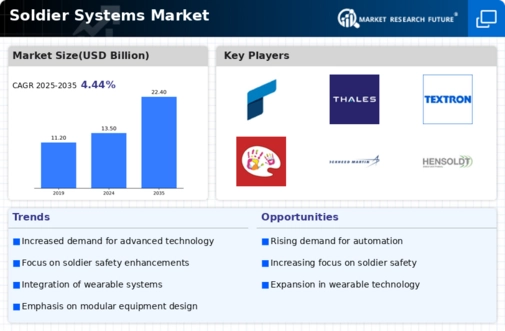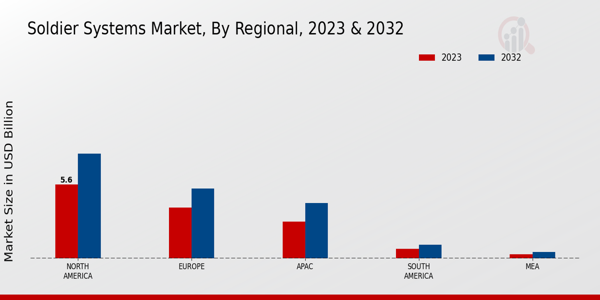Increased Defense Budgets
Rising defense budgets across various nations are a pivotal driver for the Soldier Systems Market. Governments are prioritizing military modernization to address evolving threats, which has led to increased funding for advanced soldier systems. For instance, defense spending in several countries has seen a consistent rise, with some nations allocating over 2% of their GDP to defense. This financial commitment facilitates the procurement of cutting-edge technologies, including body armor, communication systems, and weaponry. As nations strive to enhance their military capabilities, the Soldier Systems Market is poised for substantial growth, driven by the demand for innovative solutions that ensure soldier effectiveness and safety.
Emergence of Modular Systems
The emergence of modular systems within the Soldier Systems Market is reshaping how military equipment is designed and utilized. Modular systems allow for customization and scalability, enabling soldiers to adapt their gear to specific mission requirements. This flexibility is particularly advantageous in diverse operational environments, where the needs of soldiers can vary significantly. The market for modular soldier systems is expected to expand, as militaries seek to optimize resource allocation and enhance operational efficiency. By investing in modular solutions, armed forces can ensure that soldiers are equipped with the most effective tools for their missions, thereby driving growth in the Soldier Systems Market.
Focus on Soldier Health and Wellbeing
The emphasis on soldier health and wellbeing is increasingly influencing the Soldier Systems Market. Modern military operations recognize the importance of mental and physical health, leading to the development of systems that support soldier resilience. Innovations such as wearable health monitoring devices and stress management tools are gaining traction. The market for these health-focused technologies is projected to grow significantly, as militaries aim to reduce the incidence of combat-related stress and improve overall soldier performance. This focus on wellbeing not only enhances operational effectiveness but also contributes to the long-term sustainability of military personnel, thereby driving demand within the Soldier Systems Market.
Integration of Artificial Intelligence
The integration of artificial intelligence (AI) into the Soldier Systems Market is transforming operational capabilities. AI enhances decision-making processes, enabling soldiers to analyze vast amounts of data in real-time. This technology is expected to drive market growth, with projections indicating a compound annual growth rate of over 10% in the coming years. AI applications range from predictive maintenance of equipment to advanced training simulations, which improve soldier readiness. As militaries seek to leverage AI for tactical advantages, investments in AI-driven systems are likely to increase, thereby expanding the Soldier Systems Market. Furthermore, the incorporation of AI into communication systems enhances situational awareness, allowing for more effective mission planning and execution.
Advancements in Communication Technologies
Advancements in communication technologies are a critical driver of the Soldier Systems Market. Enhanced communication systems facilitate real-time information sharing among soldiers, improving coordination and operational effectiveness. Technologies such as secure satellite communications and advanced radio systems are being integrated into soldier systems to ensure reliable connectivity in challenging environments. The demand for these advanced communication solutions is projected to increase, as militaries recognize the importance of seamless communication for mission success. As a result, investments in communication technologies are likely to propel growth within the Soldier Systems Market, ensuring that soldiers remain connected and informed during operations.


















Leave a Comment